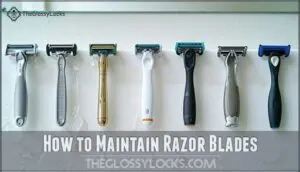This site is supported by our readers. We may earn a commission, at no cost to you, if you purchase through links.

Pat the blades dry—don’t just shake them—since even a drop of water is a welcome mat for rust. Store razors somewhere dry, or use a silica gel packet to keep moisture at bay.
Wiping a thin layer of oil over the edges helps, much like armor before battle. Avoid tapping blades on the sink, as it knocks them out of line.
With a little habit, you’ll cut down on wasted blades—and you haven’t even heard the best tricks yet.
Table Of Contents
- Key Takeaways
- Razor Blade Maintenance
- How to Maintain Razor Blades
- Preventing Rust Formation
- Protecting Razor Blades
- Extending Blade Lifespan
- Frequently Asked Questions (FAQs)
- How do I make my razor blades last longer?
- How do you keep a razor sharp?
- How do you keep razor blades clean?
- How should you store a razor blade?
- How can you prevent razor blades from rusting?
- What should you do with a razor blade after it dries?
- How to properly keep razor blades?
- How to keep razor blades from getting dull?
- How to make shaving blades last longer?
- Are certain razors more prone to corrosion than others?
- Conclusion
Key Takeaways
- You’ll extend the lifespan of your razor blades by rinsing them thoroughly after each use, patting them dry, and storing them in a dry location.
- To keep your razor sharp, you’ll rinse it after each stroke, store it dry, and strop the blade on denim weekly to realign the edge.
- You should clean your razor blades regularly by rinsing them with hot water, scrubbing them with soapy water, and applying rubbing alcohol to sanitize and remove debris.
- By applying a thin oil coating to your razor blades after they dry, you’ll prevent rust and corrosion, ensuring a longer lifespan and sharper cuts.
Razor Blade Maintenance
You can easily triple your razor blade’s lifespan with proper maintenance techniques.
These simple cleaning, sanitizing, and drying methods will keep your blades sharp and rust-free for weeks longer than normal use.
Cleaning Techniques
When cleaning razor blades properly, you’ll remove debris that causes premature dulling and bacterial buildup.
Start with hot water rinse before each shave to kill bacteria and flush away particles.
Essential razor blade cleaning techniques include:
- Soapy water scrub – Use an old toothbrush to remove skin and hair residue
- Hot water rinse – Flush debris after every stroke and shave
- Cotton ball cleaning – Clean between blade edges for thorough removal
- Alcohol sanitization – Apply rubbing alcohol to sterilize blades completely
- Commercial tools – Use products like Razorpit for deep cleaning.
These razor blade cleaning methods remove up to 90% of buildup when done consistently.
Sanitizing Methods
Five powerful sanitizing methods eliminate bacteria and extend blade life.
Rubbing alcohol offers superior alcohol efficacy—soak blades for 10 minutes or swish briefly. Hot water kills bacteria instantly; submerge blades in boiling water for 5-10 minutes.
White vinegar provides natural sterilization when mixed equally with water. Hydrogen peroxide’s bubbling action removes debris while sanitizing.
Cotton cleaning tools help apply sanitizing solutions effectively, ensuring proper blade hygiene and bacteria prevention. For ideal results, consider proper blade cleaning after each shave to maintain proper blade care.
Drying Procedures
After sanitizing your razor, proper drying becomes your blade’s best friend.
Water is the enemy of sharp steel, so you’ll want to remove every drop before storage.
Pat your razor dry with a clean towel, then give it a quick ten-second blow-dry with your hair dryer for complete moisture removal.
For electric razors, regular cleaning prevents hair and debris accumulation.
- Towel Patting – Gently pat (never wipe) to avoid damaging the blade edge
- Blow-Dry Method – Use cool air setting to prevent heat damage to plastic components
- Air Drying – Allow natural evaporation in well-ventilated areas away from humidity
- Dry Storage – Keep razors in moisture-free environments like bedroom drawers
- Silica Use – Add gel packets to storage containers for extra moisture protection
How to Maintain Razor Blades
Proper razor blade care transforms your shaving experience from a daily chore into a smooth, cost-effective routine. You’ll save money and get better shaves when you follow proven razor maintenance tips that extend blade life substantially.
A well-maintained razor blade turns shaving from a chore into a smooth, money-saving ritual you’ll actually enjoy.
Your approach to blade material matters more than you might think. Stainless steel blades respond better to maintenance than cheaper alternatives. Water hardness in your area affects how quickly mineral deposits build up on your razor. Soft water areas allow blades to last longer, while hard water requires more frequent cleaning.
Here are five core maintenance principles:
- Rinse thoroughly after each stroke to remove hair and shaving cream buildup
- Clean weekly with soapy water and an old toothbrush to eliminate skin residue
- Sanitize regularly using rubbing alcohol to kill bacteria and prevent infections
- Dry completely before storage to prevent corrosion and dulling
- Monitor shaving frequency – daily shavers need more aggressive maintenance routines
Alternative razors like safety razors require different care than cartridge systems. To further prevent rust, consider storing razors properly. Proper blade disposal protects others from accidental cuts while maintaining your razor’s performance.
Preventing Rust Formation
You can prevent rust formation on your razor blades by storing them in a dry place and applying a thin layer of oil.
Keep your razor sharp—store it dry and finish with a light coat of oil for maximum rust protection and longevity.
By taking these simple steps, you’ll be able to reduce rust and corrosion, helping to extend the lifespan of your razor blades, which is a key factor in maintaining their effectiveness and longevity.
Storing Razors Dry
You store razors dry to prevent rust.
Dry storage benefits include humidity control and material compatibility.
Ideal storage locations, like razor blade storage tips, help with razor drying and razor storage, preventing blade rust and ensuring razor blade drying for longevity.
Applying Oil Barriers
When moisture threatens your razor blade’s integrity, applying oil barriers creates an impenetrable shield against rust formation.
Household oils like baby oil, olive oil, or mineral oil work effectively for razor blade protection.
Simply coat the blade with a thin layer after each use, ensuring complete coverage.
This razor blade oiling technique displaces water molecules and prevents oxidation.
The barrier effectiveness depends on oil types and application frequency.
For ideal results, consider using oils that displace water effectively, like camellia or mineral oil.
Reapply weekly for best rust prevention and razor blade preservation.
Using Silica Gel Packets
Tiny moisture-absorbing packets work like silent guardians for your razor blade storage solutions.
Place silica gel packets in your razor case or storage container to eliminate humidity that causes rust. These packets offer excellent reuse potential – simply heat them in a low oven to reactivate.
For gel alternatives, consider rice or activated charcoal for natural moisture absorption with minimal environmental impact.
Using protective coatings and oils can further prevent rust.
Protecting Razor Blades
You’re taking the right steps to maintain your razor blades by learning how to protect them.
By following proper storage options, handling precautions, and travel protection methods, you can substantially extend the lifespan of your razor blades. Proper storage options will help you keep your blades in good condition.
Travel Protection Methods
When traveling, protect your razor with a travel case or blade cover.
- Use a dopp kit
- Wrap in paper towels
- Utilize magnetic holders
- Invest in razor travel protection for safe razor blade protection and storage tips.
Storage Options
If you want to master razor blade storage strategies, consider a few sharp moves.
Freezer Storage slows rust, Oil Baths create a barrier, and Razor Stands boost airflow.
Keep razors in cool places or use travel cases for on-the-go protection.
Many users prefer a specific blade holder for ideal storage.
Smart razor blade storage methods like these, plus drying and oiling strategies, keep your blades sharper—longer.
Handling Precautions
When handling razors, prioritize safe disposal and preventing cuts.
Guarantee child and pet safety by storing razors out of reach.
Practice careful blade handling to avoid nicks and cuts, and maintain razor hygiene to reduce dull blade risks, promoting overall razor safety.
Extending Blade Lifespan
You can extend the lifespan of your razor blades by following a few simple steps.
By sharpening, realigning, and replacing your blades properly, you can triple their lifespan and save money in the long run.
Sharpening Techniques
You’ll use denim stropping or leather honing for blade sharpening, with a recommended sharpening frequency of once per week for peak performance, similar to straight razors, which offer sharpness due to design and material.
For a simpler approach, consider using the denim method for blade maintenance, and can be maintained with commercial sharpeners for increased longevity.
Realignment Methods
Got a dull blade? You can realign it. Stropping is key. It helps straighten bent blade tips.
Here’s how:
- Try denim stropping.
- Consider leather honing.
- Know the sharpening frequency.
- Commercial sharpeners can help, but stropping works, too.
Regular stropping reduces blade replacements. Manual realignment maintains edge uniformity. Straight razors stay sharp longer. Blade grinding can also help.
Replacement Guidelines
Realigning your blades helps, but every razor has its limit.
For the best shave quality and skin safety, track your usage frequency and replace blades after 5 to 7 shaves or when you notice blade dullness and skin irritation.
Timely blade replacement boosts blade lifespan and also cuts costs, keeping your shave smooth and comfortable.
Frequently Asked Questions (FAQs)
How do I make my razor blades last longer?
Like a sharp sword that dulls with neglect, your razor needs proper care.
Rinse blades thoroughly after each use, pat dry, apply thin oil coating, and store in dry location away from humid bathrooms for maximum longevity, which includes maximum longevity.
How do you keep a razor sharp?
Keep your razor sharp by rinsing it after each stroke, storing it dry, and stropping the blade on denim weekly to realign the edge.
How do you keep razor blades clean?
Like a surgeon’s scalpel needs sterilization, your razor requires thorough cleaning after each use.
Rinse blades with hot water, scrub with soapy water using an old toothbrush, then apply rubbing alcohol to sanitize and remove remaining debris completely.
How should you store a razor blade?
Store your razor upright in a cool, dry place outside the bathroom.
Use a razor stand for better airflow and faster drying.
Consider protective cases or oil storage to prevent rust formation.
How can you prevent razor blades from rusting?
Proper storage prevents 50% of rust formation compared to bathroom storage.
Dry your razor thoroughly after use, store it in a cool, dry place, and apply a thin oil coating to block oxygen exposure.
What should you do with a razor blade after it dries?
You should apply a thin film of oil to the razor blade after it dries to prevent rust and corrosion, ensuring a longer lifespan and sharper cuts.
How to properly keep razor blades?
You dry, oil, and store razor blades in a dry place to prevent rust and extend their lifespan, ensuring sharpness and safety with each use.
How to keep razor blades from getting dull?
You can keep razor blades sharp by rinsing with hot water, using rubbing alcohol, and stropping regularly to remove debris and realign edges for peak performance.
How to make shaving blades last longer?
You can make shaving blades last longer by rinsing thoroughly, storing in dry places, and using techniques like stropping to realign and sharpen the blade edges regularly.
Are certain razors more prone to corrosion than others?
You’ll find that stainless steel razors are less prone to corrosion than carbon steel ones, due to their resistant properties.
Conclusion
Mastering how to maintain razor blades is like learning a new recipe, you’ll get better with practice.
You’ll extend their lifespan by following proven methods, like cleaning and storing them properly.
By applying these techniques, you’ll become a pro at how to maintain razor blades, saving money and getting a better shave.
- https://groomingcorp.com/
- http://www.julienfarel.com/destinations-restore-salon-and-spa-services/
- https://www.therazorcompany.com/blogs/the-benefits-of-wet-shaving/razor-blade-care-101-how-to-extend-the-life-of-your-blades?srsltid=AfmBOoqPXJR0p5rKA9gAXZ6TNBqx1zfofWr8enZIcA_DG4_m1vTksQio
- https://www.razoremporium.com/blogthe-lowdown-on-preshave-oils-benefits-and-application/?srsltid=AfmBOoroX5tzIbRbRCvFVkLBXEaDc1JTOqhqNG1XLidILSiadHuV7Y50
- https://www.reddit.com/r/lifehacks/comments/r9pqb4/remove_moisture_quickly_to_preserve_longevity_of/










